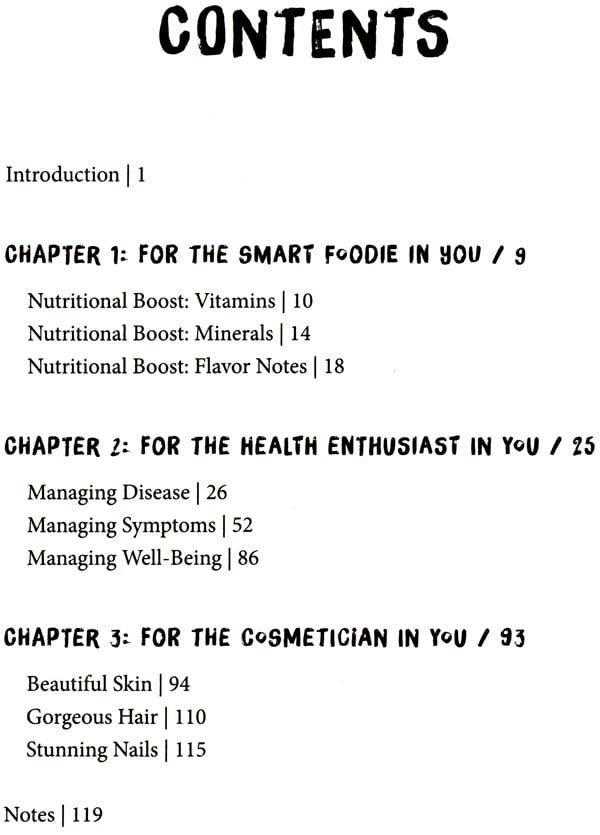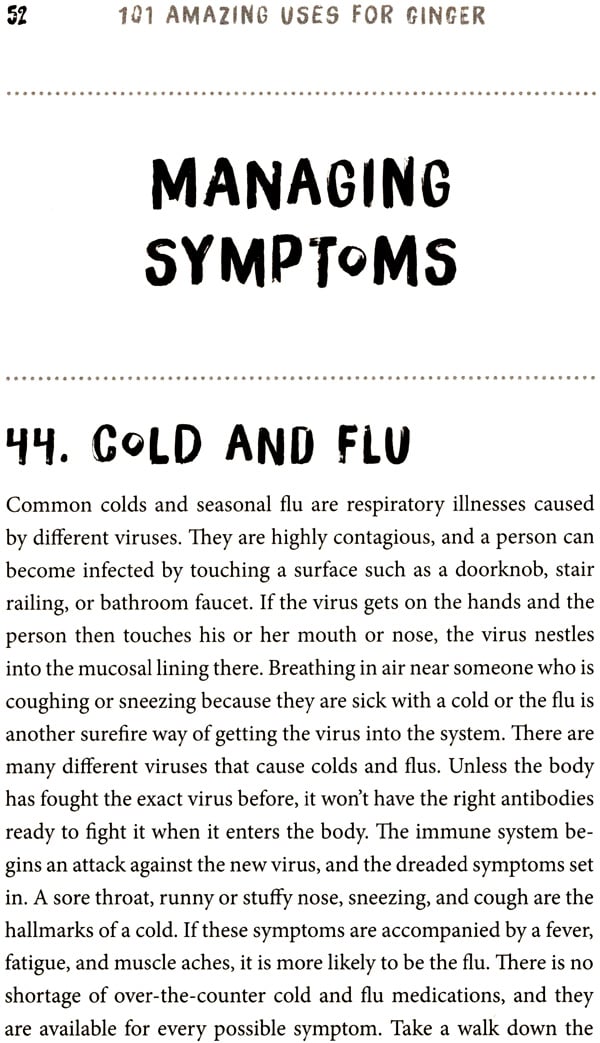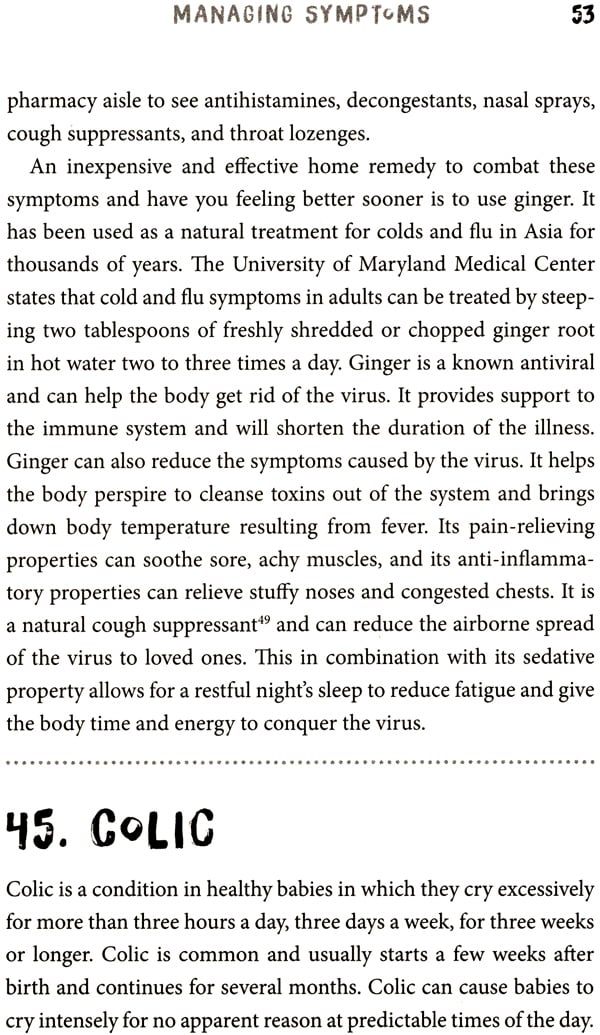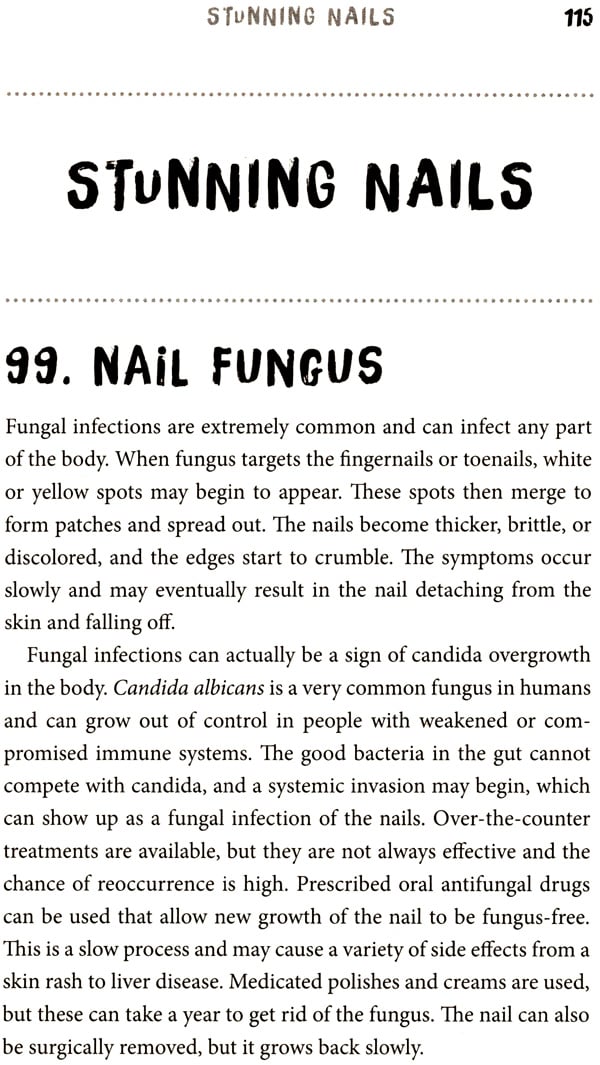
101 Amazing Uses For Ginger (Reduce Muscle Pain, Fight Motion Sickness, Heal The Common Cold and 98 More)
Book Specification
| Item Code: | NAQ997 |
| Author: | Susan Branson |
| Publisher: | Familius Publishing |
| Language: | English |
| Edition: | 2017 |
| ISBN: | 9781641700030 |
| Pages: | 136 |
| Cover: | PAPERBACK |
| Other Details | 8.50 X 6.00 inch |
| Weight | 150 gm |
Book Description
Hippocrates said, "Let food by thy medicine and medicine be thy food." Ginger's vibrant flavour is familiar to most, but did you know this knobby root can be a source of healing, nutrients, and beauty? From fighting cancer cells to taming split ends, managing nausea to preventing hypothermia, ginger's uses are incredibly diverse. Backed by the latest research, holistic nutritional consultant Susan Branson provides 101 useful-and unexpected-reasons to add ginger to your diet and daily life.
SUSAN BRANSQN earned an undergraduate degree in biology from St. Francis Xavier University, then a MSc in toxicology from the University of Ottawa. From there, she worked in research: in the field, in the lab, as a writer, and as an administrator. She took time off and stayed at home after her second child was born. In addition to being a stay-at-home mom, she also took violin lessons, photography courses, earned a diploma in writing, and ultimately became a holistic nutritionist. Susan is a member of CSNN's Alumni Association, Canada's leading holistic nutrition school.
WHAT IS THIS KNOBBY ROOT?
Most know ginger as a yellow spice in the baking aisle of the grocery store. It's in the same family as turmeric and cardamom, other familiar spices. Bought fresh, it has beige- to brown-coloured skin covering knobby, finger like projections. These projections are called rhizomes and are the horizontal stems of the plant that are found underground and from which both the upright stem and roots of the plant grow. Underneath the skin is the wonderfully aromatic ivory- to yellow-coloured flesh. When cut into, a spicy, lemony, and pungent smell fills the air.
The ginger root shows up in stores all around the world, but it is native to the warmer climates of Asia-particularly India and China-although Australia, Brazil, Jamaica, West Africa, and parts of the United States now cultivate it. It's a perennial, so it comes up every year. It has long, narrow green leaves and green-purple flowers that look somewhat like orchids.
Ginger is teeming with more than one hundred fifteen chemical constituents in the rhizome, with at least fourteen found to be bioactive. The main groups of bioactive compounds are called gingerols and shogaols, and the amount of each of these depends on where the ginger was grown, the commercial processor, and the form it is in-fresh, dried, or processed.
It is the gingerols in particular that give the ginger its pungent flavour and are thought to be responsible for most of the pharmacological actions, which is how ginger can have such a varied and significant impact on our bodies. Ginger is metabolized and readily absorbed after ingestion,' meaning that ginger gets broken down into its chemical components so they can be used by our bodies for a number of benefits. It is not surprising, then, to see some of its therapeutic benefits in these areas. Among its most notable actions are its anti-inflammatory, antioxidant, antiemetic (nausea), analgesic (pain), antipyretic (fever), antitussive (cough), and antibiotic properties. This book shows how ginger can be used to treat an incredible assortment of conditions from colds to cancer and how it is effectively used in natural beauty treatments.
WHERE DID IT COME FROM?
Having been coveted and cultivated for as long as five thousand years, ginger has stood the test of time. Our ancestors were onto something. Originating in the beautiful jungles of Southern Asia, the people of India and China are thought to be the first to have used ginger to treat their ailments and as a flavouring agent in their food and drinks. Chinese records indicate those who grew acres of ginger enjoyed great wealth, likely using it in trade. Even Confucius was a fan, reportedly never being without it at meals.
Ginger was then brought from India to Ancient Rome over two thousand years ago by Arab traders and used extensively by the Romans for its medicinal properties until the Roman Empire fell. Pedanius Dioscorides, a Greek physician travelling throughout the Roman Empire, would collect local medicinal herbs and record his findings, notes which he later turned into De Materia Medica, a vast reference book on the medicinal properties of over a thousand herbs. He wrote that ginger "is right good with meat in sauces, or otherwise in conditures: for it is of an heating and digesting quality; it gently loosest the belly, and is profitable for the stomach, and effectually opposed itself against all darkness of the light; answering the qualities and effects of pepper."2 Undoubtedly, ginger was used as a digestive aid, for flavouring, and as a warming agent. The Greeks prized ginger so highly, they mixed it into their breads to create the first gingerbreads.
Unfortunately, with the fall of Rome, ginger was lost in Europe until the eleventh century. Once reintroduced, it quickly gained popularity, surpassed only by black pepper in the fourteenth century. It was so coveted that it became very expensive. One pound of ginger was the equivalent in trade to one sheep. Queen Elizabeth I of England was noted to be especially fond of preserved ginger and had it used in the making of sweets. She is credited with the invention of the gingerbread man, a cookie popular with kids today. Toward the end of the Middle Ages and the emergence of world travel, ginger made its way to the New World with the Spanish Conquistadores. It reached the rest of the world with Western European explorers and travellers. Soon, everyone was enjoying this magnificent plant.
**Contents and Sample Pages**












